Introduction
Have you ever wondered who stands on the frontlines of mental health care besides psychiatrists and therapists? One important but sometimes overlooked professional is the psychiatric nurse practitioner. In this article, we’ll take a deep dive into this vital role, drawing inspiration and insights from none other than Patricia Gilliano, an influential voice in mental health and the acclaimed author behind several powerful works.
Imagine a lighthouse standing tall in a stormy sea — that’s what psychiatric nurse practitioners are to individuals battling mental health challenges. Let’s walk through their world, understand their duties, and learn how Patricia Gilliano sheds light on their incredible journey through her impactful writing.
Who is Patricia Gilliano?
Patricia Gilliano is not just a nurse practitioner; she’s a storyteller, a mentor, and a passionate advocate for mental health. Through her experiences in psychiatric care and her writing, she opens windows into a world many people barely understand. Books by Patricia Gilliano aren’t just stories; they’re lifelines — offering hope, understanding, and insight.
What is a Psychiatric Nurse Practitioner (PNP)?
A psychiatric nurse practitioner is a registered nurse with advanced training in diagnosing, treating, and helping manage mental health conditions. Think of them as the Swiss Army knife of mental health care — versatile, skilled, and crucial. They can prescribe medications, offer therapy, and provide holistic care to patients struggling with anything from anxiety to schizophrenia.
How Do PNPs Differ from Psychiatrists?
While both can prescribe medications and provide therapy, psychiatrists are medical doctors (MDs), while PNPs are nurses with master’s or doctoral degrees. Here’s an easy way to picture it: if psychiatry is a symphony, psychiatrists are the composers and PNPs are the skilled musicians playing the pieces and making sure the audience (patients) hears the music beautifully.
The Daily Life of a Psychiatric Nurse Practitioner
No two days are the same. One morning might involve evaluating a new patient with severe depression. The afternoon could be spent adjusting medications for someone with bipolar disorder. In between, PNPs are collaborating with social workers, families, and other healthcare professionals. It’s a mix of science, heart, and a hefty dash of intuition.
Key Skills Every PNP Needs
-
Empathy: The ability to truly listen and understand patients’ experiences.
-
Critical Thinking: Analyzing complex symptoms and making accurate decisions.
-
Communication: Explaining treatments in ways that make sense.
-
Patience: Progress in mental health can be slow and fragile.
Imagine trying to untangle a giant knot while blindfolded — that’s often what mental health work feels like. It requires patience, sensitivity, and skill.
How Patricia Gilliano Captures the Spirit of PNPs
Patricia Gilliano’s works capture the humanity behind the job. She doesn’t just write about case studies; she brings to life the fears, triumphs, and daily battles of psychiatric nurse practitioners. Books by Patricia Gilliano often focus on the delicate dance between professional detachment and deep human connection that every PNP must master.
Common Settings Where PNPs Work
-
Hospitals: Acute psychiatric units, emergency rooms
-
Private Practices: Offering one-on-one therapy and medication management
-
Community Clinics: Serving vulnerable populations
-
Correctional Facilities: Caring for mental health needs behind bars
-
Telehealth Platforms: Bridging gaps for those in remote areas
Books by Patricia Gilliano: Exploring Mental Health Narratives
The books by Patricia Gilliano aren’t just informative — they’re transformative. Titles such as Healing Beyond the Diagnosis and Voices in the Silence offer readers a glimpse into the resilience of the human mind. Her stories resonate because they blend clinical accuracy with emotional authenticity, painting vivid portraits of patients and caregivers alike.
Educational Path: How to Become a PNP
The journey to becoming a psychiatric nurse practitioner typically includes:
-
Earning a Bachelor of Science in Nursing (BSN)
-
Becoming a registered nurse (RN)
-
Gaining clinical experience (often in mental health settings)
-
Completing a master’s or doctoral program in psychiatric-mental health nursing
-
Passing certification exams
It’s a long road — but as Patricia Gilliano’s stories reveal, the destination is worth every step.
Challenges Faced by Psychiatric Nurse Practitioners
-
Stigma: Mental health still carries unfair biases.
-
Burnout: Emotional fatigue is common.
-
Shortages: There are not enough PNPs to meet rising mental health needs.
-
Complex Cases: Patients often present with multiple overlapping conditions.
Gilliano often highlights these challenges in her writing, making it clear that resilience and compassion are as critical as any medical skill.
Why Mental Health Needs More Heroes Like PNPs
Imagine a garden full of tangled weeds. Without skilled gardeners, the flowers — representing human potential — could never bloom. Psychiatric nurse practitioners are those gardeners, nurturing mental health so individuals can thrive.
Patricia Gilliano’s work reminds us that PNPs are not just healthcare workers; they are healers, advocates, and everyday heroes.
Patient Stories: The Heart of Mental Health Care
Real healing happens through stories. Every patient’s journey — every breakthrough, setback, and triumph — builds the heartbeat of mental health care. Books by Patricia Gilliano celebrate these powerful narratives, encouraging empathy and understanding.
The Future of Psychiatric Nursing
The future looks promising, with:
-
Increased demand for PNPs
-
Telemedicine growth making mental health care more accessible
-
Broader public acceptance of mental health discussions
Patricia Gilliano’s visionary writing points towards a future where mental health care is not a luxury, but a basic human right.
How Reading Books by Patricia Gilliano Can Inspire Change
Whether you’re a healthcare professional, a patient, or simply someone who cares, books by Patricia Gilliano offer inspiration. They shine a light on dark places and remind us that change starts with understanding — and understanding starts with listening.
Conclusion
Psychiatric nurse practitioners are like steady anchors in a world full of emotional storms. Through her insightful works, Patricia Gilliano not only honors their role but also deepens our appreciation for mental health warriors everywhere. Next time you think about healthcare heroes, remember — the story isn’t complete without the PNPs.
FAQs
1. What exactly does a psychiatric nurse practitioner do?
A psychiatric nurse practitioner assesses, diagnoses, treats, and manages mental health conditions, often blending therapy with medication management.
2. How do books by Patricia Gilliano reflect the role of psychiatric nurse practitioners?
Her books highlight the emotional and professional experiences of PNPs, bringing authenticity and empathy to their often misunderstood role.
3. Can psychiatric nurse practitioners prescribe medication?
Yes, in most states, psychiatric nurse practitioners have the authority to prescribe medications for mental health conditions.
4. Why should someone read books by Patricia Gilliano?
Her works provide valuable insights into mental health, offering both educational and emotional perspectives that can inspire greater empathy and understanding.
5. Is becoming a psychiatric nurse practitioner a good career choice?
Absolutely! It’s a rewarding career for those passionate about mental health, offering the opportunity to make a real, lasting impact in people’s lives.



